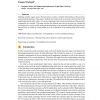Free Online Productivity Tools
i2Speak
i2Symbol
i2OCR
iTex2Img
iWeb2Print
iWeb2Shot
i2Type
iPdf2Split
iPdf2Merge
i2Bopomofo
i2Arabic
i2Style
i2Image
i2PDF
iLatex2Rtf
Sci2ools
DAGSTUHL
2010
2010
Modeling and Visualization of Cardiovascular Systems
Modeling complex organs, such as the human heart, requires a detailed understanding of the geometric and mechanical properties of that organ. Similarly, the model is only as accurate as the precision of the underlying properties allow. Hence, it is of great importance that accurate measurements of the geometric configuration are available. This paper describes the different steps that are necessary for creating and visualizing such a vascular model, ranging from determining a basic geometric model, gathering statistical data necessary to extend an existing model up to the visualization of the resulting large-scale vascular models. 1998 ACM Subject Classification I.3.8 Applications, J.3 Life and Medical Sciences Keywords and phrases Volumetric Data, Curve-skeleton, Cardiovascular Structure Digital Object Identifier 10.4230/DFU.SciViz.2010.210
| Added | 29 Oct 2010 |
| Updated | 29 Oct 2010 |
| Type | Conference |
| Year | 2010 |
| Where | DAGSTUHL |
| Authors | Thomas Wischgoll |
Comments (0)

